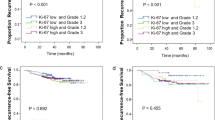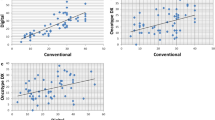Abstract
The prognostic value of Ki-67 immunohistochemical labelling was evaluated in 327 operable primary carcinomas of the breast. The follow-up time was up to 4 years (mean 2.7 years). The disease-free survival in Ki-67 positive patients was shorter than in Ki-67 negative patients (P < 0.005). By combining the Ki-67 expression with ER receptors and stage, subgroups with a different disease-free survival were identified. In stage II patients there was a significant difference (P < 0.005) in disease-free survival between Ki-67 positive/ER negative and Ki-67 negative/ER positive patients. In node negative patients there was no such difference. The disease-free survival according to different prognostic factors, stage, ER and node status, were separately examined using a Cox's proportional hazards model. ER (P < 0.0001), the Ki-67 (P < 0.02), tumour size (P < 0.0001) and nodal status (P < 0.006) were independent prognostic factors. We conclude that the potential value of Ki-67 labelling for prognostic evaluation of patients with breast carcinoma is good.
This is a preview of subscription content, access via your institution
Access options
Subscribe to this journal
Receive 24 print issues and online access
$259.00 per year
only $10.79 per issue
Buy this article
- Purchase on Springer Link
- Instant access to full article PDF
Prices may be subject to local taxes which are calculated during checkout
Similar content being viewed by others
Author information
Authors and Affiliations
Rights and permissions
About this article
Cite this article
Railo, M., Nordling, S., von Boguslawsky, K. et al. Prognostic value of Ki-67 immunolabelling in primary operable breast cancer. Br J Cancer 68, 579–583 (1993). https://doi.org/10.1038/bjc.1993.389
Issue Date:
DOI: https://doi.org/10.1038/bjc.1993.389
This article is cited by
-
Pathophysiological Characteristics of Melanoma In-Transit Metastasis in a Lymphedema Mouse Model
Journal of Investigative Dermatology (2013)
-
Topoisomerase II alpha expression and the Ki-67 labeling index correlate with prognostic factors in estrogen receptor-positive and human epidermal growth factor type-2-negative breast cancer
Breast Cancer (2012)
-
Ki-67: level of evidence and methodological considerations for its role in the clinical management of breast cancer: analytical and critical review
Breast Cancer Research and Treatment (2012)
-
Chemotherapy for muscle-invasive bladder cancer treated with definitive radiotherapy: persisting uncertainties
Nature Clinical Practice Oncology (2008)
-
Ki-67 as prognostic marker in early breast cancer: a meta-analysis of published studies involving 12 155 patients
British Journal of Cancer (2007)



